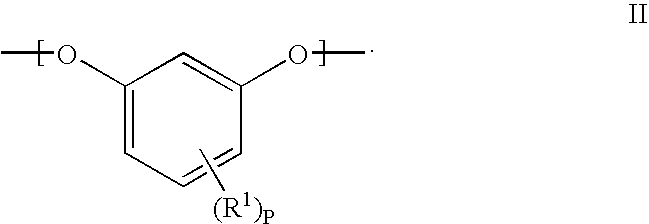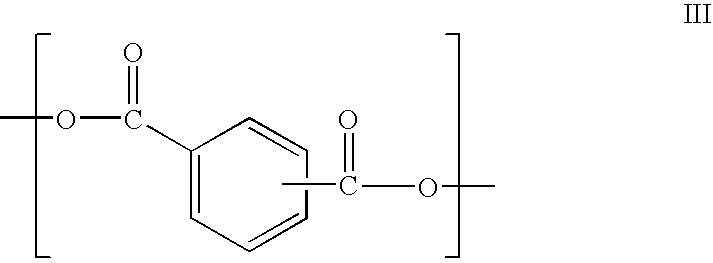Polyarylate compositions
a technology of polyarylate compositions and compositions, applied in the field of polymer compositions comprising transparent, can solve the problems of long-term color stability of polycarbonates, polyesters, poly(alkylene dicarboxylates), blends remain persistent problems, and loss of transparency and attractiveness of molded articles comprising such polymers, and loss of gloss can also be an undesirable long-term phenomenon
- Summary
- Abstract
- Description
- Claims
- Application Information
AI Technical Summary
Problems solved by technology
Method used
Image
Examples
example 1
[0081]In this example, an ITR-BPA block copolymer (the first resin) consisting of 16 mol % ITR polyarylate blocks, 7 mol % resorcinol carbonate (RSCO) blocks and 77 mol % BPA carbonate (BPACO) blocks, designated 16 / 7 / 77 (ITR / RSCO / BPACO) was prepared and then this ITR-BPA block copolymer was blended in a 50:50 powder mixture with BPA polycarbonate homopolymer.
[0082]To a stirred mixture of 1581 grams (g) of resorcinol and 28 milliliters (mL) of triethylamine in 9.2 liters (L) of methylene chloride and 1.3 L of water, was added a solution of 2030 grams of a 50 / 50 mixture of iso- and terephthaloyl chloride in 3.8 kilograms (kg) of methylene chloride at about 292 mL / minute. Concurrently, 50% sodium hydroxide solution was added at about 62 mL / minute to maintain the pH between about 4 and 7. After the acid chloride addition was completed, the caustic was slowly added until a stable pH of 7.5 to 8.5 was obtained. Then the mixture was stirred for about 10 minutes. The molecular weight (Mw) o...
example 22
[0091]In this example an 81% ITR resin was blended with a 51% ITR Resin.
[0092]To a stirred mixture of 4360 g of resorcinol, 310 g of p-cumylphenol and 100 mL of triethylamine in 29 L of methylene chloride and 4.6 L of water, was added a solution of 7309 g of a 50 / 50 mixture of iso- and terephthaloyl chloride in 13.6 kg of methylene chloride at about 525 mL / minute. Concurrently, 50% sodium hydroxide was added at about 112 ml / minute to maintain the pH between 4 and 7. After the acid chloride addition was complete, the caustic addition was slowly added until a stable pH of 7.5 to 8.5 was obtained. Then the mixture was stirred for about 10 min. ((The hydroxy-terminated polyarylate ITR molecular weight was about 12,000 g / mol by GPC calibrated with PC standards). To the solution of the hydroxy-terminated polyarylate ITR oligomer was then added 1068 g of BPA, 24 L of water and 4 L of methylene chloride. Phosgene (1350 gms) was then added via a dip tube while the pH was maintained at about ...
examples 23 – 33
Examples 23–33
[0094]In these examples resin 1, an ITR resin was blended with resin 2, another ITR Resin. Results are tabulated in Table 3 below.
[0095]
TABLE 3Composition of Resin 1Composition of Resin 2Clarity OfRSBPAITR BlockRSBPAITR BlockDifferenceResultantHazeBlendITRCOCOLengthITRCOCOLengthin ITRBlendAs Molded228281012000511534600031transparent0.9 to 1.2238281012000431443600039Some HazeNA248281012000511534600031transparent0.9 to 1.2258281012000631027850019transparentNA266310278500431443600020transparentNA27511534600019675600032Some Haze1.928431443600019675600024transparentNA292886460001967560009transparentNA3028864600000100—28Some HazeNA311967560001038760009transparentNA3219675600000100—19transparentNA3310387600000100—10transparentNA 3*828101200010387600072opaqueNA 4*828101200019675600063opaqueNA 5*631027850019675600044opaqueNA*indicates Comparative Example
[0096]The results in Table 3 illustrate that optimal transparency is achieved when the difference in polyarylate structural un...
PUM
| Property | Measurement | Unit |
|---|---|---|
| light transmittance | aaaaa | aaaaa |
| haze | aaaaa | aaaaa |
| heat resistance | aaaaa | aaaaa |
Abstract
Description
Claims
Application Information
 Login to view more
Login to view more - R&D Engineer
- R&D Manager
- IP Professional
- Industry Leading Data Capabilities
- Powerful AI technology
- Patent DNA Extraction
Browse by: Latest US Patents, China's latest patents, Technical Efficacy Thesaurus, Application Domain, Technology Topic.
© 2024 PatSnap. All rights reserved.Legal|Privacy policy|Modern Slavery Act Transparency Statement|Sitemap



